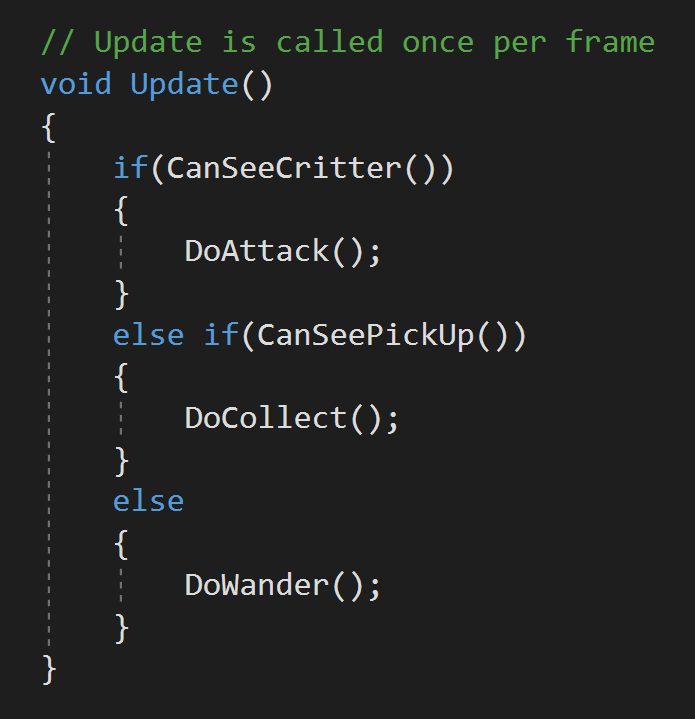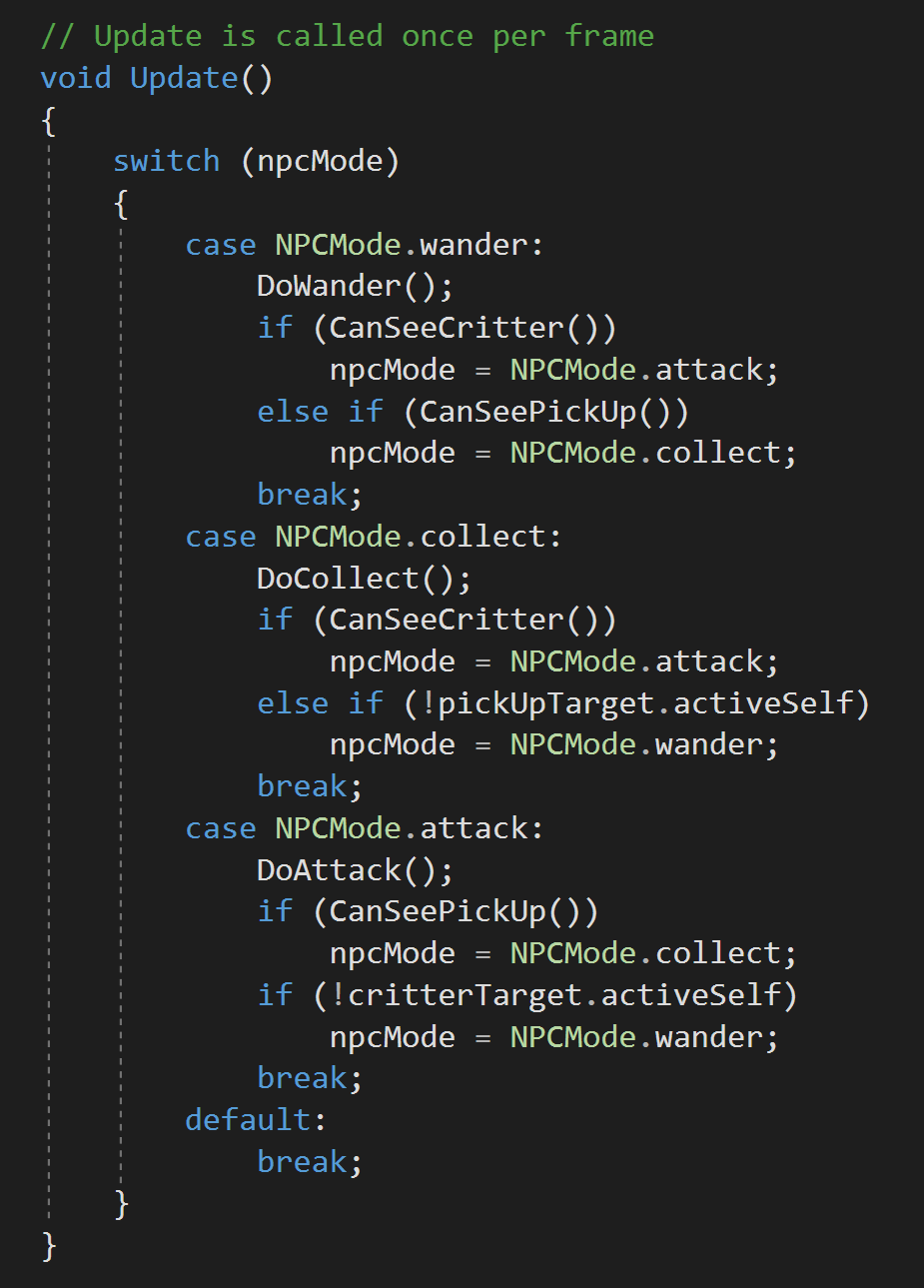The State Pattern
Whoa. It’s been nearly a year since I’ve made a post. I’ve been busy. A lot has happened, but that’s a topic for another post.
So I’m going to try something new, well a few things. But the first thing I’m going to try is writing a blog post for my next video. I figure taking the time to explain the video in writing will help me cement the ideas and provide one more resource for you all. There are many people who’d prefer to read than to watch a video. So maybe it’s a win-win? We’ll see.
But enough of that. Let’s get onto the second new thing.
That’s is exploring programming patterns. It’s something I’ve wanted to do because I want to learn more about programming patterns. Plus Bolt 2 will eventually (!!) get released and when it does many of the basic programming patterns will be far easier to implement AND folks developing with Bolt can benefit from implementing them.
Since Bolt 2 is now fully in hiding under the protection of Unity (who knows when the alpha will make it out to the public again) the upcoming video will be entirely C# based.
I should also give credit where it’s due. I’m no genius - that should be clear if you’ve read more than a few paragraphs of my writing. Much of what I know or think I know about programming patters comes from the book “Game Programming Patterns” by Robert Nystrom. It’s well worth a look if you are unfamiliar with the topic of programming patterns..
The State Pattern
“Allow an object to alter its behavior when its internal state changes. The object will appear to change its state.”
Like any other pattern the State pattern has its limitations, but also like any other pattern when used correctly it can help to detangle code which can make debugging code or adding features easier and much less frustrating. And that’s a win no matter how you look at it.
You may have heard the term “Finite State Machine” or “FSM” thrown around. Both of these terms refer to the same thing which is an implementation of the state pattern. The Unity asset Playmaker is based on the uses of FSMs and Bolt has the ability to create them with “State Macros.”
To help illustrate the state pattern, I’ve created a simple Unity project. There is a NPC played by a capsule and it’s goal is to wander around the maze and collect the yellow cubes. When it sees a red sphere (critter) it will chase it and attack it. Nothing too fancy.
So with that in mind, how would you program this behavior? Take a minute and think it through. No cheating!
Just about ready to go up on steam! ;)
This actually doesn’t look too bade with the use of functions… but will get out of control in a hurry.
I know when I first got started with C# and Unity, I would have done it with an if statement or two (or seven). And that works. It really does. Until you need to add another behavior. Or another game mechanic gets layered in. And we all know it won’t end there. The layers will continue to get added until the code breaks, bugs appear or the project gets forgotten because it was getting too hard to work with.
Simple FSM = Enum + Switch
So let’s look at the simple FSM. I still remember learning about this and was utterly confused by how to implement it but at the same time amazed at what it did to my code once I finally got it working. At that time I hadn’t really learned to use functions well so I had 100’s of lines in my update function. Needless to say it was nearly impossible to debug and when I discovered FSMs it was a major break through!
Simple FSM using an ENum and a Switch
In the case I described above the NPC behavior can be broken down into 3 different states or 3 different smaller behaviors. I thought of these as wander, collect and attack. A custom enum can then be created with these three values.
With the enum created a switch statement can be placed in the update function. For each case we can call the relevant function for that behavior. But we still need a way to change or switch (get it!) the state. For the most part this can still be done with basic if statements.
And now this may sound like we’ve back pedaled to our original solution and just made things more complex.
There is a major advantage here!
When we started, inside the update function we had to have a way to determine which state we were in - picking from ALL the possible states. Imagine how complicated that would be if there were 5, 6 or maybe even 10 different states. Yuck! Nothing clean about that.
With this method we only have to decide IF we need to change states GIVEN that we are already in a particular state. This greatly simplifies the decision making albeit at the cost of a few extra lines of code.
In a FSM it’s common that a given state can only transition to a limited number of other states. For example in my case maybe I don’t want the NPC to stop collecting if it sees a red sphere and it should only attack a sphere if it’s wandering around with no cubes in sight. If that’s the case the “state pattern” may actually reduce the amount of code needed as well as serving to untangle the code.
This implementation of the state pattern can be used for all kinds of different behaviors. It could be used to control animations, background music, or which UI elements are being displayed.
As an aside, in my personal project, I use a vaguely similar approach that makes use of a static enum and events for game modes so that various managers and UI elements can act or react based on the state of the game. The clarity of being in exactly one state has greatly simplified my code and made it far less error prone.
So this is all well and good, but you may be able to see the end result of this approach is still messy if the number of states starts to get large.
A Step Further => More Abstract + More Manageable
Having all the states switching inside the Update function can quickly get unmanagable and if nothing else is pretty hard to look at.
So let’s go one step further. This step adds another layer or two of abstraction to the system, still has some downsides but does clean up our code and will make larger FSMs easier to manage.
This step will place each state in its own (mostly) self contained class. The state will be in control of itself and will determine when to make a transition as well as determine which state to transition to.
Step 1 is to create a new interface. In my case I’ll call the interface INPCState. The interface will have just one function that will take in all the NPC data and will return a value of the type INPCState. This returned state will be the state for the next frame as the “Do Action” function will be called by the base class of the NPC which in turn will run the behavior for a given state.
The Wander State with all the functions included
Step 2 is to create a new class for each state of the FSM and that state needs to implement the interface INPCState. Each of these classes should also contain any functions or logic needed for that state. In my case I have choosen to leave all the variables on the NPC base class. This keeps each state class tidy, but does mean that the state class will be changing values on the NPC base class which is usually something I like to avoid - you win some and you lose some.
Inside each state’s “Do Action” function we need to call the relevant functions AND we need to decide which state to use for the next frame. You can see the full code to the left, but for now let’s jump back to the NPC base class which will help make sense of the return values.
Step 3 is to refactor the NPC base class. Here we need a new variable of the type INPCState that will hold a reference to the current state. We also need instances of each state - it would be possible to make this work with static classes and using an abstract class rather than an interface, but if you know what that means you can probably implement it yourself.
The simplified NPC Base Class
In the OnEnable function I’ve set the current state to the wander state to ensure that the current state variable is never null.
Then the real magic happens in the Update function. Here we have just one line! So awesome. Here we call the “do action” function on the current state and then set the current state to the value returned from that state.
That makes total sense, I swear it does, but it’s abstract.
Give a mintue to let it sink in.
This is so clean.
Step 4 is to add conditionals to the state classes to determine which state to be in for the next frame. Notice that we have passed in a reference to the NPC base class into the “Do Action” function and from there we can get a reference to the instances of the state classes.
Pro’s
The base class is exceptionally clean. You can now see how the class appears to change it’s state (behavior). Effectively the entire Update function changes depending on the current state and what in that state’s “Do Action” function. That’s cool.
If we want to add an additional state we simply create a new class, add an instance to the NPC base class and finally add conditions to allow a transition to the new state from other states.
As long as the number of states stays fairly small 5 or maybe 10 this is a pretty manageable solution.
Con’s
It’s hard to maintain if the system truly gets complex. In this case most sophicated structures such as behavior trees might be needed.
All the variables in the NPC base class are public. Which is a bit messy and not super awesome. This could be partially solved by creating a data container that itself is private in the NPC base class but has public variables… This passes the buck a bit, but would prevent those variable from being changed by classes without access to the data container. A generic data container would also potentially open the doors a bit wider for reuse of the states by other NPC types - so worth thinking about.
As mentioned before, the states are changing values of variables on the NPC base class. Not ideal and something I usually go out of my way to avoid if possible.






